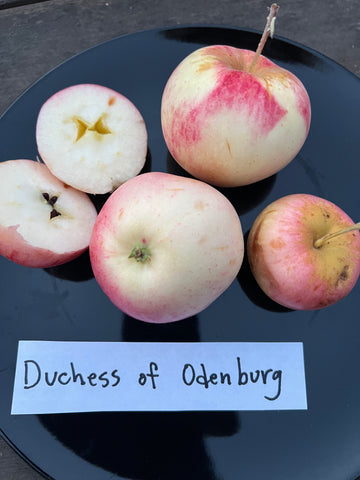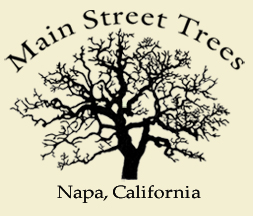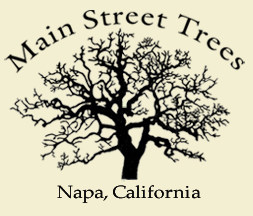Apples
Arkansas Black Spur Apple


Large, late season. Dark red skin, high quality even where summer nights are warm. For dessert and cooking. Keeps many months. Partly self-fruitful.
___________________________________
Ashmead’s Kernel Apple


Widely regarded as one of the all-time best-flavored apples. Small to medium-sized fruit with variable shape, often lop-sided. Greenish to golden brown russet skin with reddish highlights. Creamy yellow flesh is aromatic, crisp and sweet. Fruit picked early is somewhat sharp and acidic, but mellows after a few weeks off the tree. Ripens after Red Delicious, about with Golden Delicious. Keeps 3-4 months. Used for dessert, cider and sauce. Resistant to powdery mildew, somewhat resistant to apple scab. Winter hardy tree, begins bearing at young age. From England, discovered in the early 1700s. Partly self-fruitful, biggest crops with cross-pollination.
____________________________
Belle de Boskoop Apple

Highly esteemed cooking and pie apple, outstanding dessert quality as well. Heavy crops of large to very large fruits. Green and red skin in patches and stripes with a brown russet extending from the base. Coarse, crisp, juicy, creamy white flesh is richly flavored, sweet-tart to subacid, and highly aromatic. Keeps well, improves in storage. Very late harvest, with Yellow Newton Pippin and Granny Smith. Large tree, open shape with drooping branches. Originated in Holland in 1856. Sterile pollen, pollenizer required.
_________________________________
Bramley’s Seedling Apple

England’s favorite cooking apple. Large in size, with very tart, creamy yellow flesh that makes highly flavored pies and sauce. Also good for cider. First-picked fruits are mostly green, riper fruit greenish-yellow with uneven reddish or brownish stripes to brownish orange with little or no green. Fully ripened fruit is firm, juicy, less tart and suited to fresh use. Very high in vitamin C. Mid-season harvest, about with Golden Delicious. Keeps two months. Spreading tree is heavy bearing and disease-resistant. Originated in England in the early 1800s. Sterile pollen, pollenizer required.
_________________________________
Braeburn Apple

New, from New Zealand. Superb late season fruit: very crisp and tangy, more flavorful than Granny Smith. Excellent keeper. Green with dark red blush. October-November harvest. Self-fruitful.
____________________________________________
Duchess of Odenburg

Duchess of Odenburg is one of the earliest to ripen apples each year in July.
__________________________________________________
Empire Apple

Sweet and juicy, sprightly flavor, a cross of McIntosh and Red Delicious. McIntosh-type apple for hot summer climates. Heavy bearing tree. Early fall harvest. Good pollenizer for Mutsu, Gravenstein, Winesap, Jonagold. Self fruitful.
____________________
Fuji Apple

Recent introduction from Japan that quickly became California’s favorite apple. Sweet, very crisp, flavorful. Excellent keeper. Dull reddish-orange skin, sometimes russeted. Ripe mid-September. Excellent pollenizer for other apple varieties. Self-fruitful.
________________________
Golden Delicious Apple

Long-time favorite for its sweetness and flavor. Reliable producer, adapted to many climates. Pollenizer for Red Delicious. Mid-season harvest- September. Self-fruitful.
_____________________________
Golden Russet Apple

One of the great family orchard apples of 19th century America. Crisp, aromatic, subacid, creamy yellow flesh with great flavor and legendary sugary juice. Medium size. Used fresh and for cider, drying and cooking. Ripens about with Spitzenburg: late September/early October in Central California. Ripe fruit hangs on the tree until frost; fruit stored properly keeps until April. Skin partly to almost completely russeted, varying from grayish-green or greenish-yellow to an attractive golden brown with orange highlights. Winter hardy, vigorous tree, bears mostly on the tips of branches. Good disease resistance. Apparently originated in New York as a seedling of English Russet sometime in the 1700s. Partly self fruitful, biggest crops with cross-pollination
____________________________
Gold Rush Apple


Goldrush Apple won the late apple tasting event held in 2009 at Main Street Trees. It is a patented apple developed over 20 years in a cooperative breeding program between Purdue University, Rutgers and U of IL. It is a great tasting yellow late-ripening apple with excellent fruit quality and long storage ability. The name was chosen from its golden color with bronze blush and a rush of flavor. It is a winner with some disease resistance and flavor retention even after 7 months of storage.
____________________________
Granny Smith

From Australia. Large, late, green, all-purpose. Crisp, tart, excellent keeper. Requires long summer. Thrives in hot climates. 600 hours. Prolonged bloom: good pollenizer for other apples. Self fruitful.
_____________________
Gravenstein Apple (green)

Famous for sauce and baking, also used fresh. Crisp, juicy, flavorful, tart. Early bloom, early harvest. Pollen-sterile, pollenizer required: Empire, Fuji, Gala, Red Delicious
________________________
Gravenstein (Red Gravenstein)

Famous for sauce and baking, also used fresh. Crisp, juicy, flavorful, tart. Green with red stripes. Early bloom, early harvest. 700 hours. Pollen-sterile: pollenized by Empire, Fuji, Gala or Red Delicious.
_____________________________
Honeycrisp™

Winter hardy tree from the University of Minnesota. Fruit is crisp and juicy with an aromatic flavor. Striped red over yellow color. Stores well. Ripens from late September to late October. Patent # 7197
_________________________
Hudson’s Golden Gem

One of the largest and best-flavored russet apples. Crisp, sugary, juicy flesh with flavor described as nutty by some, pear-like by others. Conical in shape with a very distinctive appearance: a smooth, uniform, grayish-gold or light yellowish-brown russet over the entire surface. Ripens after Jonagold, about with Melrose. In most climates where it is grown, the fruit hangs on the tree into winter. Good keeper. Medium-sized, vigorous, winter hardy tree. Resistant to scab, mildew and fireblight. Fruit tends to crack the first two or three years only. Chance seedling discovered in a fence row at Tangent, Oregon. Introduced in 1931. Partly self fruitful, biggest crops with cross-pollination.
_____________________________
Jonagold Apple

Superb flavor – connoisseurs’ choice. A cross of Jonathan and Golden Delicious. Yellow with red-orange blush. Crisp, juicy, all-purpose. Pollenized by Fuji, Gala, Granny Smith or Red Delicious, but not Golden Delicious.
______________________
Niedzwetzkyana


Niedzwetzkyana is one of the earliest to ripen apple in July. The red color inside and out is brilliant. The apple lacks a sweetness but really makes up for it!
_______________________
Northern Spy Apple

Large, fruit is firm and aromatic with a lively, tart flavor. Greenish-yellow skin with red blush or stripes. Dessert/cooking, excellent keeper. Winter hardy, vigorous tree. Slow to begin bearing. Harvest about 10 days after Golden Delicious. Pollenized by Golden Delicious.
_______________________
Pink Lady (Cripps Pink)

Hot climate apple from Western Australia. Very crisp, sweet-tart, distinct flavor, good keeper. Skin reddish-pink over green when ripe. White flesh resists browning. Harvest begins late October, about three weeks after Fuji. Self-fruitful. Pat.No. 7880
_____________________________
Pink Pearl Apple

Unusual pink-fleshed, highly aromatic fruit. Medium size, cream and pale green skin, sometimes blushed red. Tart to sweet-tart, depending on time of picking. Early fall harvest. Good keeper. Makes colorful, tasty applesauce. Early, profuse, pink blossoms in spring. Pollenizer required.
_________________________________
Red Fuji
Redder-skinned bud sport of Fuji. Sweet, very crisp and flavorful, excellent keeper. Ripe September-October in Central Calif. Excellent pollenizer for other apple varieties. Self-fruitful.
_______________________________

Old variety, regarded by some connoisseurs as the very best dessert apple. Red over yellow skin, yellowish flesh. Firm, juicy, moderately sweet, renowned flavor. Good keeper. 800 hours. Pollenized by midseason blooming apples.
--------------------------------------------------
Tydeman’s Late Orange Apple
Richly flavored connoisseurs’ favorite. More productive and easier to grow than Cox Orange Pippin: much lower incidence of cracking; consistently better flavor and quality in hot summer climates. Reddish-orange stripes over greenish-yellow ground color, some russeting. Yellowish flesh is firm and juicy. Harvest late September/October, about with Fuji. Good keeper. Small but vigorous tree with long, weeping branches. Early, heavy thinning required to prevent alternate bearing. Resistant to mildew and scab. Laxton Superb x Cox Orange Pippin, from England, introduced in 1945. Pollenizer required, a mid to late-blooming variety such as Gala, Fuji, Golden Delicious or Granny Smith. Delicious. Pollenized by Golden Delicious.
___________________________
Waltana Apple

Waltana is a selection from Albert Etter of Humbolt Co, CA. It is a very lovely and aromatic winter apple. The yellow flesh has a nice sweet to tart balance and the apple is firm and crisp with great flavor. It is an apple that improves in flavor as it hangs on the tree even after the leaves have dropped. It is great for eating, cooking and cider.
________________________________
White Winter Pearmain

High quality, all-purpose apple—an old favorite, especially for fresh use. Widely adapted, including California’s mild-winter coastal climates. Medium to large size, round to oval shape, pale yellow skin with dull red blush. Cream-colored flesh is fine-grained, crisp, juicy and aromatic with a rich, subacid to sprightly flavor. September/October harvest, good keeper. Healthy, vigorous, spreading, heavy-bearing tree. Excellent pollinator for other apples.
Believed to be the oldest known English apple, dating back to 1200 A.D. Self fruitful.
___________________________________
Yellow Newton Pippin Apple

Yellow-green, late, firm, crisp, slightly tart, superb flavor. For peak flavor and acid/sugar balance, wait to harvest until cheeks are yellowish-green (late Oct./ early Nov.) Good keeper. Famous for cooking, excellent fresh or dried. Vigorous tree. Self-fruitful.
___________________________________

